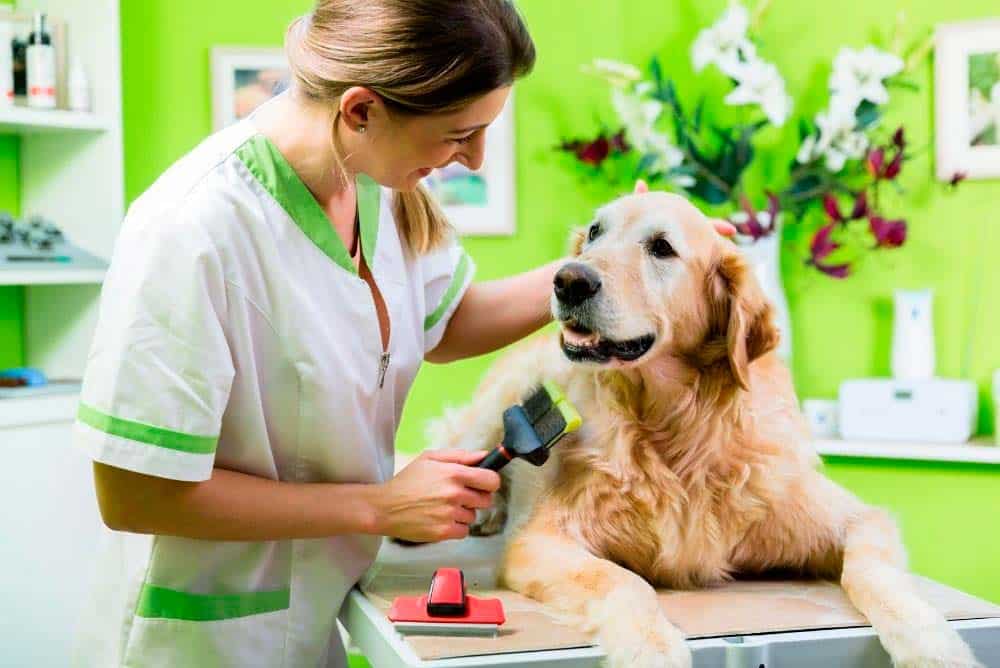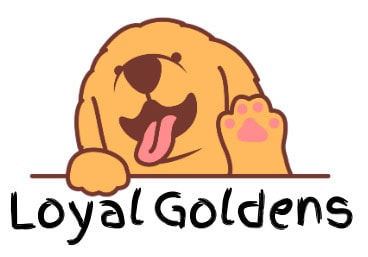Let’s face it, Golden Retrievers are heavy shedders. As much as we love them, their constant shedding can drive us buggers. Owners of goldens are always looking for tools to help deal with all their fur. The FURminator is one of those tools that people often use to brush and remove excess fur from their dog but is the FURminator safe to use on a Golden Retriever?
The FURminator is not safe for Golden Retrievers if used regularly, as it can damage their coat and irritate their skin. The FURminator is, however, a great tool for cleaning and maintaining the coat of your golden retriever if used only occasionally.
In this article, we’ll take a closer look at this popular grooming tool as well as examine the anatomy of a golden retriever’s coat and the need for proper grooming practices on long hair dogs.

(This article may contain affiliate links and loyalgoldens may earn a commission if a purchase is made.)
Unlock your goldens natural intelligence and see just how quickly problem behaviors disappear.This is the best at home dog training I've ever used!
By the end of this article, you’ll know exactly why the FURminator is not suitable for regular use on your beloved Golden Retriever. In addition, I’ll share what tools are safe and effective for regularly removing excess fur from your golden.
What Is the FURminator?
The FURminator (Amazon) is a specialized undercoat rake comb that is designed to remove the accumulated fur of both large and small breeds of dogs.

Discover how to train your Golden Retriever by playing games: 21 games to play with your Golden that will make them smarter and better behaved!
Before we dive into why this comb has sparked a debate among golden retriever owners, it’s good to examine the makeup of a golden retrievers coat and regular grooming practices to understand the process.
Double Coated Breeds
Dog breeds differ in many ways. The hundreds of varieties range from massive Siberian huskies to ferocious chihuahuas (just kidding), and a dog’s fur is just one of many variations in appearance that differentiate one breed from another. The broadest categories for dog fur are “single coat” and “double coat”.
As the name implies, a double coat refers to a second layer of fur, close to the dog’s skin that usually has a soft, wooly appearance. The upper layer, known as guard hairs, serve to repel moisture and dirt, while the denser undercoat provides insulation and protection from extreme temperatures.
This dense undercoat is usually shed twice a year and is responsible for the endless clumps of fur that will inevitably find their way into every inch of your home. Because of the texture and quantity of undercoat, these breeds require much more maintenance than single coat breeds.
Here are a few examples of dog breeds that have double coats:
- Alaskan Husky
- Australian Shepherd
- Shiba Inu
- Shetland Sheepdog
- Scottish Terrier
- Miniature Schnauzer
- Golden Retriever
As you can see, the presence of an undercoat is not limited to only large, or only small dogs, although it is common in breeds native to colder areas, as well as many working dogs who spend most of their lives outdoors.
Undercoat Blowout
Twice a year in the spring and fall, your dog will shed large amounts of their undercoat on a blowout. This happens as the season changes, and it’s a natural process that helps your dog adjust to changes in temperature and weather.
The dog’s wild counterpart, the wolf, deals with this seasonal blowout by rubbing on trees and rolling in the dirt to remove the undercoat and facilitate shedding.
Domesticated dogs do this as well by rubbing on the walls and furniture in your home. It’s better, and less messy if we provide our dogs with some shedding assistance, so they can remain happy and comfortable.
Regular grooming is important, and if your dog’s coat is not well maintained, this blowout will leave clumps of hair everywhere and will be a much messier issue than if regular brushing sessions take place.
Undercoats and Grooming
Golden retrievers and other dogs with undercoats require a much higher maintenance level than other breeds because they have so much more fur. Without regular (preferably daily and minimally weekly) brushing, your dog’s undercoat can become matted, which is uncomfortable for the pup and may require a visit to the groomer to remedy.
This becomes especially important when a seasonal blowout is taking place. These simple steps will help you effectively manage your dog’s undercoat and ensure they are happy and healthy, whatever the season.
The Tools You Need for Grooming
Here are the tools you will need to manage your golden retriever’s undercoat:
- Slicker Brush. This is a brush with short, tightly packed wires arranged on a flat or slightly curved head. Slicker brushes are often used for dematting, as well as general grooming. This slicker brush is a top choice on Amazon and includes a self-cleaning feature.
- Dematter. For especially tough mats, a dematter rake is often used. Dematters come in many styles but are often a single-sided rake with thin teeth that don’t damage smooth fur but remove mats. They are especially useful for undercoat mats. Take a look at this one on Amazon.
- Shedding Blade. This is a tool with forward-facing teeth that are used to free shedding fur in the undercoat. The FURminator is an example of a shedding blade.
- Pin Brush. Great for general grooming, this is a tool with widely spaced, flexible pins that clean debris and can untangle snags in a dog’s outer coat. This pin brush (Amazon) is suitable for everyday grooming.
Weekly Golden Retriever Grooming Guide
Follow these simple steps as a guide for grooming your Golden:
- Dematting. The first step is to untangle any mats that have developed in your dog’s undercoat. By using small strokes, the dematter will slide through the fur and only react with clumped and matted fur. The more often this is done, the easier it is since mats won’t have a chance to form.
- Use a Shedding Blade. This tool will help remove the loose undercoat fur before it can shed and infest your home. Using short strokes with the grain of the dog’s fur, pull the shedding blade through the undercoat, occasionally stopping to remove hair from the tool. Once the blade stops collecting hair, this step is done.
- Bath Time. While the first two steps should be a part of your routine, how often you bathe your dog is a matter of lifestyle and preference, although once a week is a good rule of thumb. Either in the sink or the tub, use a flexible shower attachment to thoroughly soak, apply shampoo and rinse, being careful not to get any shampoo in their eyes or water in their ears.
- Dry and Brush. Towel dry your pup once they’re clean. Many people like to take a slicker brush to their freshly bathed dog to smooth out hairs and complete the grooming process.
Along with these weekly dematting sessions, daily brushing with a pin brush is a great way to keep your dog’s coat clean and smooth.
Golden Retrievers and the FURminator
The FURminator has gotten a lot of hype from dog owners, namely because of how successful it is at de-shedding large amounts of undercoat fur.
However, it’s also become a topic of contention among golden retriever breeders because it can potentially damage a Golden’s coat and irritate their skin. This is not to say that there is no place for the FURminator in your golden retriever’s grooming arsenal.
Most owners and breeders have turned to other options for daily or weekly grooming sessions because of the impacts of regular use of the FURminator. However, it still is a useful tool for occasional de-shedding sessions. This is especially true around the time of year when your golden retriever is going through undercoat blowout.
Since FURminator recommends that dogs be bathed, conditioned, and dried before using the tool, some golden owners have come up with a solution that can reduce the potential harm to your golden’s coat and skin.
During the bath session, use a rubber grooming brush (Amazon) on your golden retriever. This helps to break down the dense undercoat fur, but it will give your dog a nice massage that is sure to put a smile on their face. This will make the FURminator session less damaging while still ensuring a thorough cleaning and de-shedding.
Conclusion
The relationships we form with our pets are powerful bonds that make life much better, and no one wants to hurt their furry friends.
This is why FURminators and golden retrievers have sparked such a hot debate among breeders and owners. Some people argue that this tool has no place in the world of golden grooming. In contrast, others believe if used correctly, for occasional de-shedding sessions, the FURminator is a useful tool.
The fact is that only you, as a golden retriever owner, know what is best for your companions, and it’s best to consult with a breeder and veterinarian when considering adding the FURminator to your grooming tool chest.
More Golden Retriever Articles You’ll Love!
- How to Take Care of Your Golden Retriever’s Coat: Step-by-Step
- The 19 Best Toys Golden Retrievers Will Actually Play With!
- How to Care for Golden Retriever Ears (Step-by-Step Guide)
- How to Care for Golden Retriever’s Teeth: A Step-by-Step Guide
